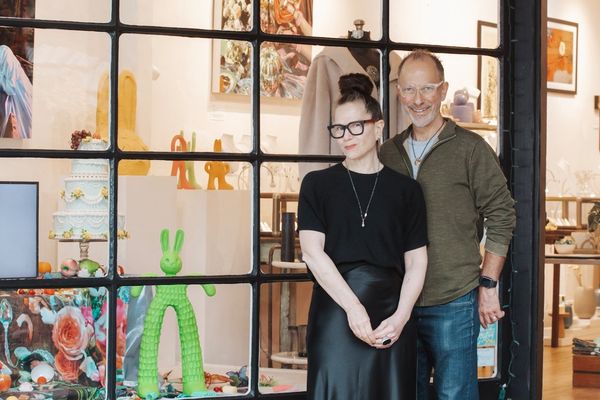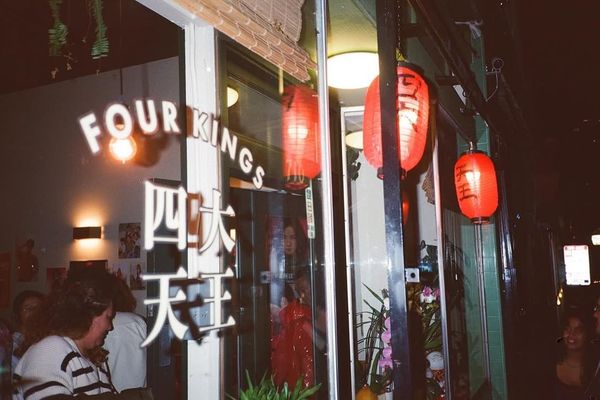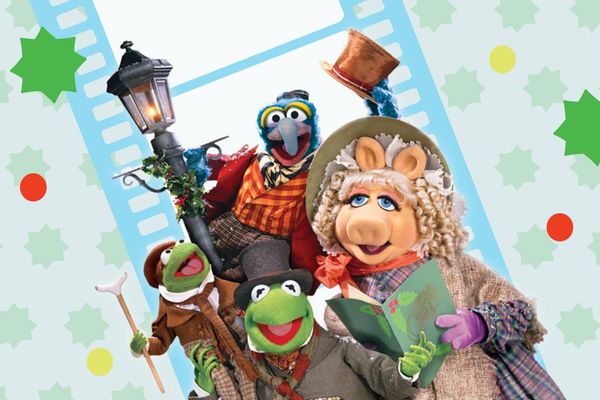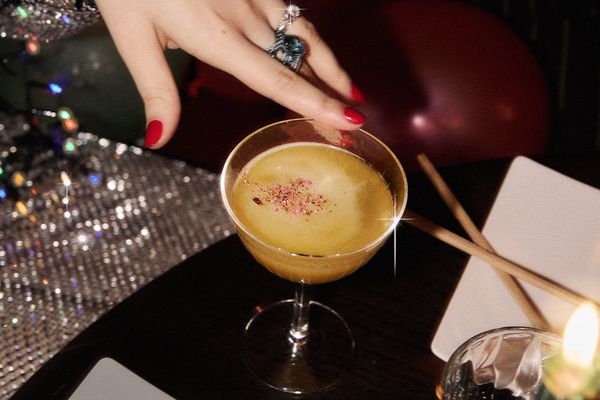The last time artists Dorka Keehn and Brian Goggin threw a block party, it was nothing short of epic. Their installation at Broadway and Columbus entitled “Language of the Birds” resulted in all-night, open-air revelry to celebrate the blinking books that straddled Columbus Avenue in front of City Lights bookstore. Awards and accolades followed. Fast forward five-plus years, they’re back with another magically surreal artwork and celebratory evening.
"Caruso's Dream" is the former—13 grand piano replicas made of glass and steel hanging precariously over a Ninth Street sidewalk, as if tumbling from the sky, is a tribute to opera star Enrico Caruso, who was awakened from sleep at the Palace Hotel by the 1906 earthquake and didn't know whether he was awake or dreaming.
To prep for this Sunday’s (2/23) unveiling of “Caruso’s Dream” at Avalon Bay, we caught up with Keehn at The Costume Shop at A.C.T. In between picking a costume for the fete, the artist—who also serves on the board of the city’s Arts Commission—drops some hints on what to expect at the party and dials us in to the public art scene.
CL: Give us a sneak peek of your big unveiling.
DK: We’re going to close the block down and do a recreation of that night when Enrico Caruso was in SF. He was the most famous tenor who ever lived. He went and spent a night in the Palace Hotel, and woke up to the night of the 1906 earthquake. The rest is a surprise, but I will say that Caruso’s original recordings have been programmed into the show.
CL: How are you going to follow up “Language of the Birds”?
DK: “Language of the Birds” was a lot of fun to do. It wasn’t quite epic on the performance level as this is going to be. There’s a lot of pressure, because we are still completing the artwork. We’re working with all these folks, like the thirteen piano players, the three opera singers, and the performer, who we’re wanting to keep as a secret. What I’m saying to people is Caruso’s ghost may appear. We think Caruso left his soul in SF that night. He went running off the next day, but there’s part of him that’s still here. He’s going to come back and connect back to SF.
CL: Should we bring anything to the party?
DK: Masks to get into the dream state. We’ve also asked everyone to bring an FM radio, so people can actually get to be part of the performance.
CL: How do you and Brian work together?
DK: We’re working in Brian’s vernacular, so it’s like he’s the chef, and I’m the sous chef.
He’s very interested in things that hang off buildings. [See “Defenestration.”] He really comes out of this magic realist experience, that magic is happening right here. What’s fun is, the more we work together, the more the creative juices start flowing. I’ll be thinking of something and he’ll be like, "I’m thinking about this," and there’s real synergy. On the other hand, he knows about stuff that I don’t know about. I never held a power tool until I meant Brian. I’m very good at producing and dealing with everything the city has to deal with when you’re dealing with very large scale work, which he really appreciates.
CL: How did “Caruso’s Dream” get commissioned?
DK: This was commissioned by the developer [Avalon Bay] as part of the city’s 1% tax for the arts. In SF, if you build a building over 25,000 square feet, in the downtown area, you have to spend 1% of the cost of your building to art that is accessible to the public.
CL: Speaking of public art, how would you like people to think about and appreciate it?
DK: I love that our art is being seen for the first time by a public that might not necessarily go to a museum. Ninth Street between Market and Mission is a pretty gritty place, and some of the first people who’ve seen that work haven’t been to a museum maybe ever.
I love the fact that you can take art outside of walls and that you can have different experiences with it. For example, “Language of the Birds,” you can walk underneath it, you can see it from different angles. Now people are bringing their instruments, and having concerts underneath it, and bringing their children. and reading the words below. You get to interact it in ways that you wouldn’t be able to at a museum. You get to yell; you get to jump around. The same thing with [“Caruso’s Dream”]. You get to see it driving. You can walk underneath it. You can hear it through your FM radio. You can see it from the building if you’re living on the second floor.
CL: Any plans to spruce up public transportation?
DK: In SF when there’s any civic construction, for example, the central subway that’s going from Fourth to Chinatown, there’s a 2% tax, and we’re commissioning all sorts of artists to put art in these different stations. For the Moscone entrance, we just purchased a very large 140-foot tall stainless-steel sculpture. Each subway station will have at least one, if not different types of artworks above ground or inside.
CL: What’s your criteria for curating public art?
DK: We pick art with a multiple sort of menu. One is price tag. We look at whether we have time to have a site-specific commission, because that’s always nicer. For SFO, we wanted to have a few big names that enhance our collection for the city. In other areas, when we do projects in neighborhoods, we really want to make sure we have neighborhood artists. We’re always trying to do the best that we can and have the most interesting art, not safe art.
CL: Any cities that you look to for inspiration?
DK: I personally am very interested in what Chicago and Seattle are doing. They have great programs, and developing a public art strategy.
CL: What’s SF’s strategy?
DK: You know, public art has a bad name. I’m interested in getting rid of that. I want to say that art in the public can be just as interesting as you could see in a gallery or museum.
[We ask] how does SF want to be seen? What are themes that are interesting to us? How do we want to be seen by the rest of the world? How do we want to have a conversation with the rest of the world. When you have great art, it draws tourists from around the world. Bay Lights is an example of that. It’s put SF on the map in a different way; all of a sudden, we’ve become an art beacon too. The fact that we’re going to have a new MOMA in a big new building—that’s going to draw attention to SF and attract tourists. We want a city that reflects that level of art. We don’t want schlocky art.
Celebrate the latest work from artist duo Dorka Keehn and Brian Goggin; the unveiling happening of "And My Room Still Rocks Like a Boat on the Sea (Caruso’s Dream),” a permanent site-specific artwork commissioned by Avalon Bay. Sunday, 2/23, dusk (around 6pm). Free and open to the public. 55 9th Street (Market Street).





















